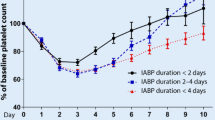Abstract
Aortic valve disease (AVD) has similarities to atherosclerosis in the case of aortic stenosis. The important role of platelet in the pathogenesis of atherosclerosis is known. The goal of this study is to evaluate whether platelet disorders play any role in aortic valve disease. We used patients with idiopathic thrombocytopenic purpura (ITP) for this study. We evaluated any association between ITP and AVD using a large inpatient database. The International Classification of Diseases, Ninth Revision, and Clinical Modification (ICD-9-CM) codes for ITP and AVD from the Nationwide Inpatient Sample (NIS) database were used for this study. Uni- and multivariate analyses were performed on data from 2002 to 2011 to evaluate any association between ITP and AVD. In the 2002 database, AVD was present in 1.73% of ITP patients versus 1.12% in the control population (odds ratio [OR], 1.56; 95% confidence interval [CI], 1.34–1.81; p < 0.001). In the 2011 database, AVD was present in 1.96% of ITP patients versus 1.33% in the control population (OR, 1.48; 95% CI, 1.30–1.68; p < 0.001). ITP remained independently associated with AVD following a multivariate logistic regression analysis adjusting for age, gender, diabetes mellitus, hypertension, and hyperlipidemia in 2002 (OR, 1.35; 95% CI, 1.16–1.57; p < 0.001) with a trend of this association in 2011 (OR, 1.12; 95% CI, 0.98–1.27; p = 0.096). ITP was strongly associated with AVD over the 10-year period analyzed in a large inpatient database. The reason for this association is not known warranting further investigations.

Similar content being viewed by others
References
AD (2017) Assessment of aortic valve disease - a clinician oriented review. World J Cardiol 9(6):481. https://doi.org/10.4330/wjc.v9.i6.481
Maurer G (2006) Aortic regurgitation. Heart. 92(7):994–1000. https://doi.org/10.1136/hrgt.2004.042614
Maganti K, Rigolin VH, Sarano ME, Bonow RO (2010) Valvular heart disease: diagnosis and management. Mayo Clin Proc 85(5):483–500. https://doi.org/10.4065/mcp.2009.0706
Leopold JA (2012) Cellular mechanisms of aortic valve calcification. Circ Cardiovasc Interv. 5(4):605–614. https://doi.org/10.1161/CIRCINTERVENTIONS.112.971028
Cary T, Pearce J (2013) Aortic stenosis: pathophysiology, diagnosis, and medical management of nonsurgical patients. Crit Care Nurse 33(2):58–72. https://doi.org/10.4037/ccn2013820
Otto C (2004) Aortic stenosis: even mild disease is significant. Eur Heart J 25(3):185–187. https://doi.org/10.1016/j.ehj.2003.12.010
Nkomo VT, Gardin JM, Skelton TN, Gottdiener JS, Scott CG, Enriquez-Sarano M (2006) Burden of valvular heart diseases: a population-based study. The Lancet 368(9540):1005–1011. https://doi.org/10.1016/S0140-6736(06)69208-8
Hinton RB (2014) Advances in the treatment of aortic valve disease: is it time for companion diagnostics? Curr Opin Pediatr 26(5):546–552. https://doi.org/10.1097/MOP.0000000000000137
Bhatia N, Basra SS, Skolnick AH, Wenger NK (2016) Aortic valve disease in the older adult. J Geriatr Cardiol JGC 13(12):941–944. https://doi.org/10.11909/j.issn.1671-5411.2016.12.004
Wang MK, Lam G, Lamelas P et al (2018) Traditional cardiovascular risk factors and the risk of aortic valve disease: a systematic review. J Am Coll Cardiol 71(11):A2089. https://doi.org/10.1016/S0735-1097(18)32630-5
Swinkels M, Rijkers M, Voorberg J, Vidarsson G, Leebeek FWG, Jansen AJG (2018) Emerging concepts in immune thrombocytopenia. Front Immunol 9:880. https://doi.org/10.3389/fimmu.2018.00880
Chandan JS, Thomas T, Lee S et al (2018) The association between idiopathic thrombocytopenic purpura and cardiovascular disease: a retrospective cohort study. J Thromb Haemost 16(3):474–480. https://doi.org/10.1111/jth.13940
Feudjo-Tepie MA, Le Roux G, Beach KJ, Bennett D, Robinson NJ (2009) Comorbidities of idiopathic thrombocytopenic purpura: a population-based study. Adv Hematol 2009:1–12. https://doi.org/10.1155/2009/963506
Enger C, Bennett D, Forssen U, Fogarty PF, McAfee AT (2010) Comorbidities in patients with persistent or chronic immune thrombocytopenia. Int J Hematol 92(2):289–295. https://doi.org/10.1007/s12185-010-0636-3
Russo A, Cannizzo M, Ghetti G et al (2011) Idiopathic thrombocytopenic purpura and coronary artery disease: comparison between coronary artery bypass grafting and percutaneous coronary intervention. Interact Cardiovasc Thorac Surg 13(2):153–157. https://doi.org/10.1510/icvts.2011.271296
Fruchter O, Blich M, Jacob G (2002) Fatal acute myocardial infarction during severe thrombocytopenia in a patient with idiopathic thrombocytopenic purpura. Am J Med Sci 323(5):279–280. https://doi.org/10.1097/00000441-200205000-00010
Álvarez-Román MT, Fernández-Bello I, Jiménez-Yuste V et al (2016) Procoagulant profile in patients with immune thrombocytopenia. Br J Haematol 175(5):925–934. https://doi.org/10.1111/bjh.14412
Htun NM, Peter K (2013) Coagulation disorders and aortic stenosis: a chicken and egg question? J Thromb Haemost 11(4):731–732. https://doi.org/10.1111/jth.12182
Natorska J, Marek G, Hlawaty M, Sadowski J, Tracz W, Undas A (2011) Fibrin presence within aortic valves in patients with aortic stenosis: association with in vivo thrombin generation and fibrin clot properties. Thromb Haemost 105(02):254–260. https://doi.org/10.1160/TH10-09-0612
O’Brien JR, Etherington MD, Brant J, Watkins J (1995) Decreased platelet function in aortic valve stenosis: high shear platelet activation then inactivation. Heart 74(6):641–644. https://doi.org/10.1136/hrt.74.6.641
Jacobson RJ, Rath CE, Perloff JK (1973) Intravascular haemolysis and thrombocytopenia in left ventricular outflow obstruction. Br Heart J 35(8):849–854. https://doi.org/10.1136/hrt.35.8.849
Gawaz M, Neumann F-J, Ott I, Schiessler A, Schömig A (1996) Platelet function in acute myocardial infarction treated with direct angioplasty. Circulation 93(2):229–237. https://doi.org/10.1161/01.CIR.93.2.229
Author information
Authors and Affiliations
Corresponding author
Ethics declarations
Conflict of interest
The authors declare that they have no conflict of interest.
Ethical approval
This article does not contain any studies with human participants performed by any of the authors.
Additional information
Publisher’s note
Springer Nature remains neutral with regard to jurisdictional claims in published maps and institutional affiliations.
Rights and permissions
About this article
Cite this article
Haseefa, F., Movahed, M.R., Hashemzadeh, M. et al. Idiopathic thrombocytopenic purpura is strongly associated with higher prevalence of aortic valve disease. Ann Hematol 99, 2081–2084 (2020). https://doi.org/10.1007/s00277-020-04170-8
Received:
Accepted:
Published:
Issue Date:
DOI: https://doi.org/10.1007/s00277-020-04170-8




